Results are in: Qualcomm’s Snapdragon X Elite goes toe-to-toe with Apple’s new M3 Pro processor
Many people thought Qualcomm’s forthcoming Snapdragon X Elite processor for Windows laptops would be outdated due to Apple’s new M3 chip. That’s not the case at all.

What you need to know
- Qualcomm recently announced its Snapdragon X Elite platform with Oryon CPU, which packs 12 performance cores and can peak at 4.3GHz.
- The platform is claimed to be faster and more efficient than Intel and Apple’s M2 processor.
- However, last week, Apple announced its M3 line of CPUs, with many Apple fans noting how Qualcomm’s chip is already outdated.
- New Geekbench 6 benchmarks show that not only does Oryon beat out Apple’s M3 in multicore, but the higher device TDP model runs a close race to Apple’s M3 Pro chip.
Qualcomm’s Snapdragon X Elite platform is not due until sometime in the first half of 2024, pushing towards summer. Still, it made a lot of waves not only due to the claims Qualcomm made at its annual Snapdragon Summit but also because it ran live benchmarks for the press to verify the results. The platform, which the new Oryon 12-core processor powers, is claimed to be upwards of 70% more efficient than Intel’s best 13th-gen mobile processors and 30% more efficient when matching Apple’s M2 processor at peak speed.
But there are a few minor issues over Qualcomm’s seemingly impressive jump in performance. For one, it doesn’t come out until mid-2024 (possibly in May, we’re hearing). The other is that Intel has its new Meteor Lake processors coming out in weeks, and Apple just announced its expected M3 bump, which is now shipping. That makes all those benchmarks relative but a tad outdated, especially since Intel’s Meteor Lake is a considerable jump in efficiency and performance, as claimed by the company.
Recently, those Apple M3 chips have been reviewed, primarily to critical acclaim, and we can see how they compare to Qualcomm’s Snapdragon X Elite and its Oryon processor (via Geekbench 6).
The results are surprising and tend to favor Qualcomm.
Geekbench: Apple M3 vs Qualcomm Snapdragon X
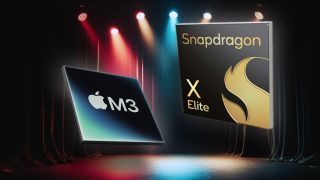
Using Geekbench 6, which is a platform-neutral benchmarking app that can handle both x86 processors like Intel and AMD and ARM-based ones like Apple’s M-series and Qualcomm Snapdragon, is one of the go-to benchmarks for laptops, desktop PCs, tablets, and even smartphones. (The other, which is restricted to PCs but also works on x86 and ARM64, is Cinebench 2024, which has been optimized for Apple silicon and Qualcomm’s platform.)
• We chat with Qualcomm about Snapdragon X Elite and Windows
Pulling results from Geekbench leaderboards, we can understand how Apple’s finalized M3 chips compare to Qualcomm’s, which are still being optimized (I say this as I expect Qualcomm to improve those benchmarks slightly as its drivers get finalized and it tweaks the chips before release).
Get the Windows Central Newsletter
All the latest news, reviews, and guides for Windows and Xbox diehards.
In short, not only does Qualcomm beat the M3 in multicore (while running slightly behind in single core), but it also runs neck and neck with the Apple M3 Pro, coming within range of each other and effectively making it a dead heat.
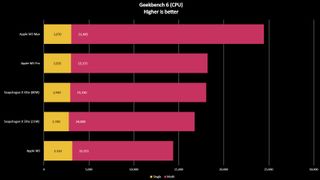
To be clear, Qualcomm tested two PC configurations: One with a device TDP (Thermal Design Power) of 80W and the other with a device TDP of 23W. These don’t vary in cores, like Apple’s M3, M3 Pro, and Max chips, but instead run at different processor frequencies, resulting in dissimilar thermal recommendations (more on device TDP versus chip TDP below, as it’s a crucial distinction many people do not understand when making comparisons).
When looking at the lower-clocked Snapdragon X Elite (23W), it peaks at 4.0 GHz and runs multithread at 3.4 GHz. It runs just below the Apple M3 on a single core, which runs at 4.05 GHz (an increase from 3.49 GHz of the M2-series), resulting in a Geekbench score of 2,780 (Qualcomm) versus 3,163 (Apple), favoring Apple.
But the story doesn’t end there.
Apple’s M3 loses by a wide margin in multicore, where Qualcomm gets 14,000 on Geekbench and Apple only eeks out 11,211. That’s not even close. Of course, that shouldn’t be too surprising. The Snapdragon X Elite runs 12 performance cores versus Apple’s 8 (4 performance, 4 efficiency ones, which are clocked lower).

Turning to the faster Snapdragon X Elite running at a peak of 4.3 GHz and multithread at 3.8 GHz, the single core is much closer at 2,940 (versus 3,163 for Apple), but the multicore performance jumps from 14,000 to 15,130, blowing way past Apple’s M3 at 11,211. (Qualcomm claims from multiple runs of Geekbench that the single-core upper limit score for the Snapdragon X Elite (80W) is 2,979.)
That means, overall, Qualcomm’s Snapdragon X Elite should be the faster system, and modern CPUs run with all cores running in some capacity. (That said, Apple’s GPU will likely be much better than Qualcomm’s).
Give Qualcomm some credit here. The company is coming out with its first-gen Oryon processor, and not only does it do well against the M2 series, but it also competes very well against the new M3 and M3 Pro.
The story gets more interesting with Apple’s M3 Pro, which has 12 cores (6 performance, 6 efficiency). There, Apple edges out the top-tier Snapdragon X Elite with a single core 3,035 and a multicore of 15,173. Qualcomm managed 2,940 (or 2,979 via Qualcomm’s numbers) and 15,130, but those are all within the margin of error if running the test multiple times (we know this as all of Apple’s M3s are clocked at 4.05 GHz and only vary in core count, yet we see the M3 “beating” M3 Pro on a single core).
You must give Qualcomm some credit here. The company is coming out with its first-gen Oryon processor, and not only does it do well against the M2 series, but it also competes very well against the new M3 and M3 Pro (M3 Max is much more powerful due to it having 16 cores versus Qualcomm’s 12).
Snapdragon X Elite challenges Apple M2, not Pro or Max

Since Qualcomm’s news came out, I’ve seen many Apple fans in my Twitter feed comment that a “better” comparison is between the Apple M2/M3 Pro and even Apple M2 Max (the M2 Max only had 12 cores but was bumped to 16 for the M3 Max).
Qualcomm doesn’t see it this way, and it was very clear that Apple M2 is what it sees as its competition. That said, if we’re being honest, it is Intel and AMD that are Qualcomm’s real competition, as most humans don’t jump between PC and Mac when buying a new laptop and instead tend to stick with one ecosystem or even one brand due to familiarity. Qualcomm wants you to choose Windows laptops powered by its processor over Intel’s.
But here’s why Qualcomm is correct in its M2 comparison.
Apple has three SKUs for its mobile processors, e.g., Apple M2, M2 Pro, and M2 Max. (There is also M2 Ultra, which is only used in desktops like Mac Studio and Mac Pro.) Those models don’t vary on speeds but core count and memory, so you often see photos of the chips scaling larger as you go from M2 to M2 Max.

Qualcomm hasn’t done that. Not yet, at least.
Currently, it announced just ONE model for the Snapdragon X platform: Elite with 12 performance cores.
There is no reason why it can’t scale up to 16 and even 20 cores for even more powerful chips or scale down to 8 or even 4 cores for more affordable laptops. Indeed, you can bet it will, as the whole point and benefit of ARM design is scalability, which Apple nicely demonstrates. (Qualcomm also confirmed this during a Q&A with the press at its Snapdragon Summit).
Suppose we take Qualcomm’s word that Snapdragon X Elite is a competitor to the Apple M2. In that case, there’s a good chance we’ll see something like Snapdragon X “Pro” with 16 cores or Snapdragon X “Max” with 20 cores, which will go up against Apple’s Pro and Max series (my guess is Qualcomm will call them something different).
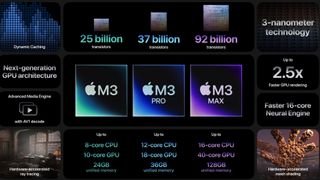
Were Qualcomm to do that, based on current benchmarks, Qualcomm would very likely continue to blow past Apple in multicore performance (while also possibly being slightly more efficient).
Again, I can hear the Apple fans saying, “But that’s because Qualcomm has more cores!” While true, core count is not the end-all regarding CPU performance.
Just ask AMD.
The Intel Core i9-13900K has 24 cores and 32 threads, while AMD's Ryzen 7 7800X3D has just 8 cores and 16 threads. Yet, they both go head-to-head in performance. The Ryzen 9 7950X, which also competes against Intel’s best 13th gen, is "only" 16 cores but has 32 threads.
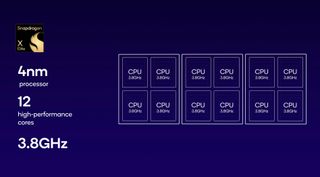
Core count, while important, is only one criterion for chip performance. Clock speed, cache size, memory structure, and the chip’s architecture also matter, so AMD often competes against Intel using fewer cores, costing less money, and using less power.
The same is true with Qualcomm versus Apple. There’s a lot more to those chips than just core count.
Device TDP ≠ CPU power draw
Another line of criticism I’ve been hearing is Qualcomm’s top-tier Snapdragon X Elite "uses 80 watts of power", which is much higher and less efficient than Apple’s 36 watts for something like the Apple M2 Max.
Game over, right?
Not really.
Qualcomm quoted those TDP numbers as device TDP, not processor TDP. Device TDP is the total heat dissipation that needs to be considered when designing a cooling solution for that laptop. That’s right, TDP is not always about direct power draw. Device TDP includes power and heat considerations from the combined GPU, storage, RAM, CPU, and other components that may generate heat. When matched with a laptop maker’s thermal goals, it can go fanless, passive cooling (vents), active cooling (fan), dual fans, heat pipes, etc.
Qualcomm announced just ONE model for the Snapdragon X platform: Elite with 12 performance cores. It has to scale it up to compete against Apple's M3 Pro and M3 Max.
While it’s safe to assume that a device with 80W device TDP does draw more power, ergo generates more heat, than a laptop with a device TDP of 23W, you can’t infer from that comparative processor efficiency or the power draw of the processor.
That’s just now how this all works.
This is what is neat about the Snapdragon X Elite. It can scale on power and heat considerations so that makers of laptops can create designs they want, with battery goals it wants to achieve for a specific market.
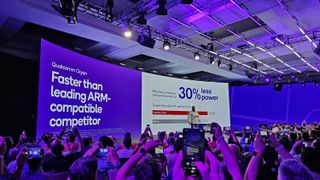
Apple has something similar. While the M2 Max is rated for 36W TDP, when combined with the GPU, its TDP is 79 watts, according to NotebookCheck.
So, you are likely rightly wondering what is the TDP of the processor itself. That is, putting the thermal part aside, what is the actual power draw of the Snapdragon X Elite?
We don’t know! Qualcomm hasn’t shared that information yet.
For clarification, the 23W and 80W cited during keynotes and benchmarking sessions were referring to device TDP - not the platform's, which we still have not disclosed. X Elite is scalable to OEM needs. Hope this helps!October 31, 2023
Likewise, Apple is cagey with its performance-per-watt claims, only noting that when matching the M1’s peak performance (so the M3 is not running at its actual higher speed), the new M3 uses 50% less power. Qualcomm claims it uses 30% less power than the M2 (in single-core) when matching peak performance, but Apple doesn’t compare M3 to M2, so the math gets fuzzy.
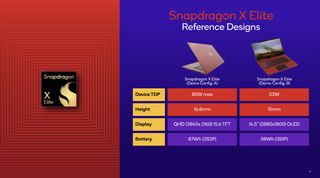
Of course, we’ll have to do benchmarks to verify that. Still, between the different core speeds, device TDP, processor TDP, battery size, and display technology, it will be challenging to get an exact, pardon the pun, apples-to-apples comparison in battery life.
The key takeaway is that don’t sleep on Qualcomm’s claims. Its Snapdragon X Elite is a groundbreaking start and a leap forward for Windows laptops. Even if Qualcomm’s first-gen is slightly behind the M3 series, you can bet it won’t take long to catch up, which is great for consumers. Additionally, NVIDIA is rumored to be getting in on the ARM PC action in 2025, which likely means high-end gaming laptops using NVIDIA’s proprietary CUDA technology, which could answer Apple’s other area of strength: the GPU.

Daniel Rubino is the Editor-in-chief of Windows Central. He is also the head reviewer, podcast co-host, and analyst. He has been covering Microsoft since 2007, when this site was called WMExperts (and later Windows Phone Central). His interests include Windows, laptops, next-gen computing, and watches. He has been reviewing laptops since 2015 and is particularly fond of 2-in-1 convertibles, ARM processors, new form factors, and thin-and-light PCs. Before all this tech stuff, he worked on a Ph.D. in linguistics, watched people sleep (for medical purposes!), and ran the projectors at movie theaters because it was fun.
-
naddy69 "In short, not only does Qualcomm beat the M3 in multicore..."Reply
Why are you STILL comparing to the M3? That is only 8 cores! Of COURSE the 12 core X Elite beats it. That is nothing to brag about.
The only comparison that matters is the 12 core M3 Pro. Of COURSE the 16 core M3 Max beats the X Elite.
And BTW, which M3 Pro are you comparing to? There is an 11 core M3 Pro available in the 14" MacBook Pro. The M3 Pro in the 16" MacBook Pro is 12 cores.
Based on the fact that the earlier claims were about "trouncing the M2 in the 13" MacBook Pro" - which is 8 cores AND 1.5 years old! - I am skeptical of these claims also. -
Daniel Rubino Reply
RTFAnaddy69 said:"In short, not only does Qualcomm beat the M3 in multicore..."
Why are you STILL comparing to the M3? That is only 8 cores! Of COURSE the 12 core X Elite beats it. That is nothing to brag about.
The only comparison that matters is the 12 core M3 Pro. Of COURSE the 16 core M3 Max beats the X Elite.
And BTW, which M3 Pro are you comparing to? There is an 11 core M3 Pro available in the 14" MacBook Pro. The M3 Pro in the 16" MacBook Pro is 12 cores.
Based on the fact that the earlier claims were about "trouncing the M2 in the 13" MacBook Pro" - which is 8 cores AND 1.5 years old! - I am skeptical of these claims also. -
ShinyProton In the end, these numbers only indicate both processors are from the same generational breed - which is already an immense feat for Qualcomm.Reply
I was already pretty impressed by the 8cx Gen 3 abilities. Now, the X Elite will push this to an even greater level. -
Daniel Rubino Reply
Agree. The "vs Apple" stuff is good for context (and is fanbait, no doubt), but Qualcomm doesn't actually need to beat Apple at all. They just need to beat Intel and AMD, which it looks like they will.ShinyProton said:In the end, these numbers only indicate both processors are from the same generational breed - which is already an immense feat for Qualcomm.
I was already pretty impressed by the 8cx Gen 3 abilities. Now, the X Elite will push this to an even greater level. -
bio Let’s see the results in real world usage because afaik Windows for ARM still doesn’t shine in x86 emulation and we all knows this is really important support in the Windows world (way more than in the Apple ecosystem).Reply -
Village_Idiot Qualcomm: We have a chip that can compete in the ARM CPU space.Reply
Intel: Meh.. . We don't think it's going to be much of a threat.
Me: I'm thinking Intel is about to let themselves get kicked in the nuts. -
dkstrauss Reply
Apple: We have an M1 chip that will replace Intel.Village_Idiot said:Qualcomm: We have a chip that can compete in the ARM CPU space.
Intel: Meh.. . We don't think it's going to be much of a threat.
Me: I'm thinking Intel is about to let themselves get kicked in the nuts.
Intel: Meh.. . We don't think it's going to be much of a threat.
Me: Why is Intel doubled up over there in the corner crying in pain? -
bradavon Why no mention of x86 emulation?Reply
It wasn't peformance and battery that made M1 a success, it was MacOS' x86 translation layor support. It would've tanked just like WoA if current apps in 2019 were slow.
Then when that wasn't a problem people were also thrilled with peformance and battery.
What's Microsoft doing about this?
It seems MS is hoping enough apps will be ported to ARM it won't matter but that's never going to happen. Windows has even older x96 apps in use than MacOS ever had.
Let's hope the Snapdragon X really does make this irelevant. It's a tall ask though isn't it. -
bradavon Reply
Agreed but but how so are Qualcomm beating Intel and AMD?Daniel Rubino said:Agree. The "vs Apple" stuff is good for context (and is fanbait, no doubt), but Qualcomm doesn't actually need to beat Apple at all. They just need to beat Intel and AMD, which it looks like they will.
They're not in a real world sense.
Microsoft arent addressing the elephant in the room. This possibly all means nothing if 86 emulation is still a problem.
It's never been a raw power issue, not really. Windows on ARM tanked because of how Windows handles x86 apps. -
Daniel Rubino Reply
While relevant, I'll say this: Previously, 8cx performed like an 11th Gen Core i5 U-series, but under emulation, it dropped below that, so you 'felt it.'bio said:Let’s see the results in real world usage because afaik Windows for ARM still doesn’t shine in x86 emulation and we all knows this is really important support in the Windows world (way more than in the Apple ecosystem).
With Oryon performing better than an Intel 13th Gen HX processor (literally a modified desktop CPU) and matching M3 Pro through sheer power, you're not going to notice the impact.
This is true of Rosetta2, too, for Apple. But it started with M1, which was already miles ahead of 8cx, so it was never an "issue."
To quote MacRumors: "Rosetta 2 running x86 code appears to be achieving 78%-79% of the performance of native Apple Silicon code."
Apple's Rosetta2 performance wasn't a zero-sum game, either. But sheer power overcomes that performance deficit. It has improved since M1, just like Windows x86 emulation has improved since Windows 11 came out.